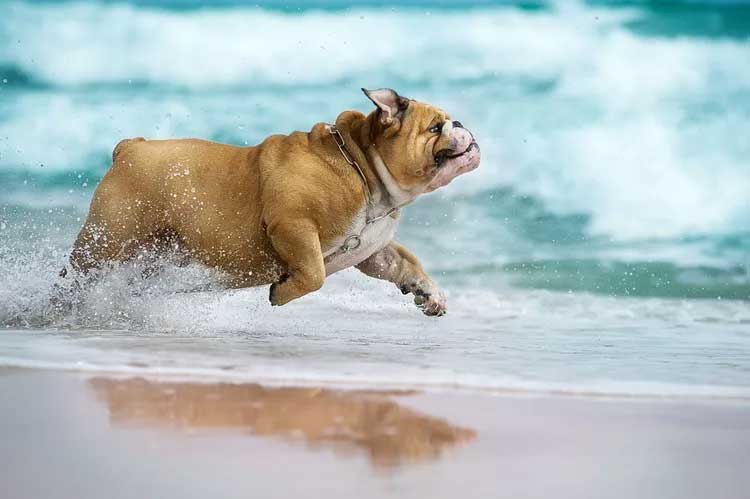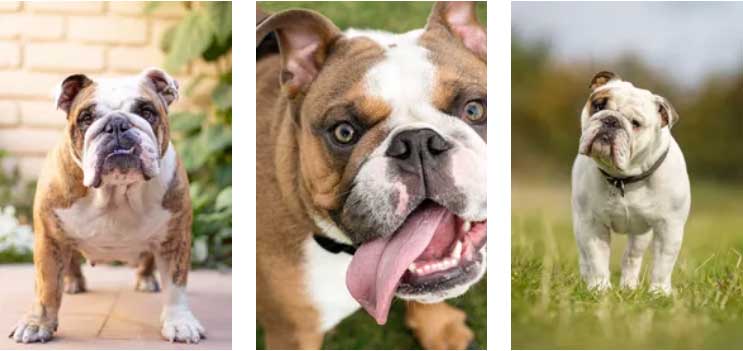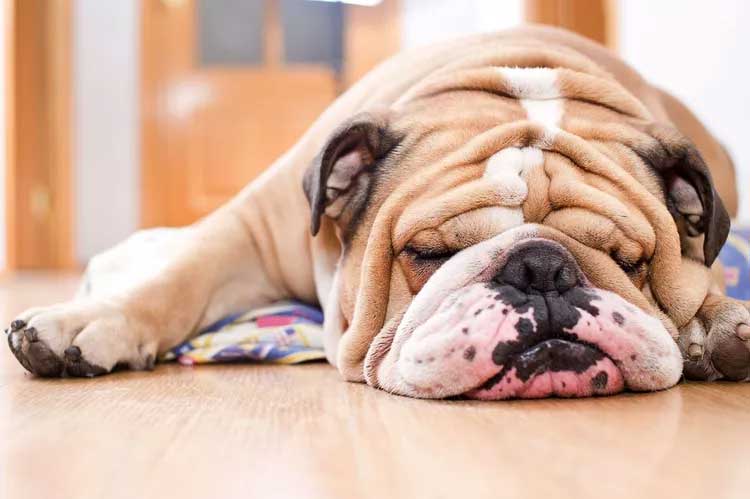Found in schools and businesses all across the country, the bulldog is a worldwide symbol for tenacity. They are courageous, but also incredibly gentle, and they have a special fondness for children. Learn more about the timeless bulldog here.

Bulldog Overview
| OFFICIAL NAME | Bulldog |
| COMMON NAME | Bulldog |
| PET HEIGHT | 14 to 15 inches |
| PET WEIGHT | 40 to 50 pounds |
| LIFESPAN | 8 to 10 years |
| GOOD WITH | cats, children, dogs, families |
| TEMPERAMENT | friendly, gentle, playful, protective |
| INTELLIGENCE | low |
| SHEDDING AMOUNT | normal |
| EXERCISE NEEDS | medium |
| ENERGY LEVEL | lazy |
| VOCAL LEVEL | when necessary |
| DROOL AMOUNT | high |
| BREED GROUP | non-sporting |
| BREED SIZE | medium (26-60 lbs.) |
| COAT LENGTH | short |
| COLORS | fawn, red, white |
| PATTERNS | brindle, flecked / ticked / speckled |
| OTHER TRAITS | apartment-friendly, easy to groom, high potential for weight gain, low prey drive, prone to health issues |
You know a classic English bulldog when you see one. He is characteristically big-boned, goofy, and full of love. Although they were originally bred as fighting dogs—and later became a worldwide symbol for toughness and tenacity—the bulldog evolved into a gentle, family oriented dog who just wants to watch the world go by from the comfort of his bed.
You're also likely to see this handsome breed on TV, patrolling the sideline at a college football or basketball games, or in the movies, famously trying to keep an inflated Aunt Marge from floating away. It's no wonder you find them everywhere, the bulldog is the fifth-most popular breed in America.

Appearance
English bulldogs (also known as British bulldogs) are probably the first thing that comes to mind when anyone says "bulldog." They are a 40–50 pound mid-sized dog with sturdy, short limbs and a wide blocky body. They're beefy boys and girls. A staple trait is their huge underbite, and sometimes the pups will "hang a fang."They're also known for their overhanging skin, a nose rope, and wrinkled face. English bulldogs sit low to the ground and have wide shoulders, two characteristics that behooved them in their dog fighting history. The American Kennel Club (AKC) lists four colors in their breed standard: red, white, fawn, and fallow. They can be any combination of these with additional brindling, ticking, or black masks. Their eyes should always be dark brown or black.
You won't confuse an English bulldog for the other members of the bulldog family. The French bulldog is smaller and has tall bat ears. The American bulldog is an athletic all-purpose working dog with longer legs and a leaner body made to guard, hunt, or farm. The Olde English Bulldogge, a larger, more muscular mix of English bulldogs, pit bull terriers, American bulldogs and bullmastiffs, is the least common bulldog.
Temperament
A bulldog's temperament is far more friendly and goofy than he may look. Although they're intimidating physically, bulldogs are actually extremely family and kid friendly. "As far as temperament, they are delightfully sweet if socialized early, otherwise they will become territorial and unmanageable with other dogs and animals," Sarah Hodgson, author, trainer, and applied behaviorist with the International Association of Animal Behavior Consultants, says. "While generally compliant with people they can also become defensive with strangers if not positively socialized to the general comings and goings of everyday life."Bulldog puppies must get plenty of exposure to kids, people, and animals to get that characteristic laid-back attitude. The more positive interactions they have with new situations, the better off they'll be. The bulldog is rarely aggressive. In fact, he's almost dopey. He doesn't always understand what you're saying, but he's kind and earnest in his ways.
Living Needs
Bulldogs are a relaxed breed that prefers to be indoors. Their low energy level means they can thrive as apartment dwellers. They certainly don't need a huge yard to run and romp, as they'll get tired after 10 minutes of playing and need a snooze. The bulldog absolutely loves children and will put up with all the noise, yanking and tugging that come with them. They'll never show anger; they'll just walk away if they feel bothered.This breed doesn't bark a ton, but they make great watch dogs that can frighten someone off with their appearance alone. They are also known for having courage, and will protect their loved ones no matter what. Bulldogs prefer a slow life lounging on the couch or squeezing onto your lap (yes, even at 50 pounds). They are a brachycephalic breed, meaning they have a wide skull and a flat face that can make exercise tough. Their heavy heads and chest make them poor swimmers and they should be watched closely around water to avoid drowning.
Care
A bulldog's coat is very fine and short, so they only require brushing once a week. The more you brush, the less hair you'll find on your furniture and clothing. More important than brushing is keeping his face clean and dry—with so many wrinkles, they can get irritated or infected if not cared for properly. Trim his nails once a month or so, until you can't hear him click-clacking on the floor. Weekly or daily teeth brushing will prevent future vet visits down the line.While the bulldog doesn't care much for exercise, he still needs it to maintain a healthy weight, as he is prone to weight gain. A daily walk around the neighborhood (during the cooler hours) will wear him out, as will a quick play session. He would much rather be cuddling with his child companions or taking a nap in the AC. Consult your vet about the right food for your bulldog, and monitor that food intake to prevent weight gain. Bulldogs are better off with two measured meals a day rather than leaving the bowl out all the time. If nobody stopped them, they'd keep eating.
Because they can be lazy, bulldog owners need to have focus and patience with their puppy. "The best training for a bulldog is positive encouragement, and engagement when they have the energy and interest in it," Hodgson says. "With bulldogs, nothing should ever be forced, repetitive, or heavy handed, lest they become, well, bullish." Keep training sessions short to ensure you have their full attention, and they'll be able to retain information better. Once he learns something, he will remember it, especially if treats are involved.

Health
As sweet as they are, bulldogs have a tough time when it comes to their health. That short, bullish stature can give way to joint or respiratory difficulties. "Roly-poly as puppies, they grow into mature adults who may have trouble navigating their world as other dogs do," Hodgson says. "With short legs and a barrel heavy stature, they're prone to weight gain and chronic joint pain…Osteoarthritis and degenerative joint disease." The Bulldog Club of America recommends that all bulldogs get a cardiac exam, a patella evaluation, and an evaluation for tracheal hypoplasia.The brachycephalic bulldog can get overheated quickly, so he shouldn't be left in enclosed warm spaces and must be monitored outdoors. Always have plenty of water, shade, and access to AC for your bulldog to reduce the likelihood of heat stroke.
History
The modern day bulldog is quite the turnaround from his ancestors. In the 13th century in England, bulldogs were used for the sport of "bull baiting," the AKC writes. Before we had professional sports, spectators would gather and bet money on this inhumane practice. One or multiple bulldogs would attempt to pin a bull to the ground using their powerful bite. These early bulldogs were slightly taller and more muscular than today's English bulldog, and only the most aggressive were bred. The AKC writes that the bulldog's tenacious character stems from their history in the ring, because they developed a high pain tolerance and kept fighting until the last second.It wasn't until 1835 that bull baiting was outlawed in England, and bulldogs faced extinction without that purpose. Many people admired the strength, determination, and appearance of the breed, and didn't want to see them die out. Luckily, there were breeders who dedicated their lives to re-engineering the bulldog. They used only the even tempered dogs to reproduce, until only the docile were left. In 1886, the English bulldog was recognized by the AKC.
The dog that originated in England has come to symbolize their people. The dog was personified in wartime Prime Minister Winston Churchill, who's credited with steadfastly leading Britain during World War II. And, well, he looked like a bulldog, too. Today, the bulldog is known as one of the most gentle, kid-friendly dogs in the world.
Fun Facts
President Calvin Coolidge owned a bulldog named "Boston Beans," who lived in the White House with the family and their other pets. President Warren G. Harding also had a bulldog in the White House, Old Boy.Yale was the first university in the United States to adopt a mascot—a bulldog named Handsome Dan. Today, dozens of colleges and universities use a bulldog as their mascot.
One of those college mascots, Drake University's Griff, tried his best to meet all the presidential candidates he could ahead of the 2020 presidential election.
Otto, a bulldog from Lima, Peru, set a world record in 2015: "the longest human tunnel traveled through by a dog skateboarder." Whatta dog.